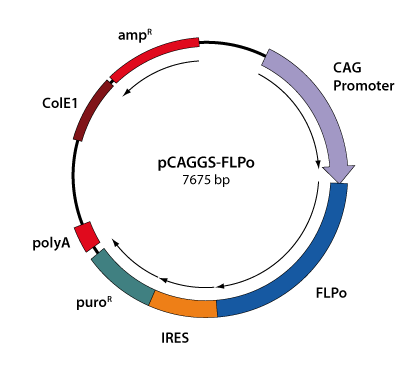 Back to list
Back to list
pCAGGS-FLPo
Manual [PDF] Contact Support Order
Limited Use Licence
The use of the this product is governed by the terms and conditions of the limited use license: FLPo Material.
The use of FLPo is covered by United States Patent Application Serial Number 12/307,418 owned by Fred Hutchinson Cancer Research Center (FHCRC), Seattle, Washington. Non-profit and academic institutions have permission to use the plasmid solely for research purpose. For-profit entities require a license from FHCRC.
Description
Site-specific recombinases (SSRs) like Cre, FLP or Dre are valuable tools in functional genomics and have been applied in various organisms. They mediate recombination between target sites of 32-34 base pairs (bp) in length. The target sites, which are called loxP, FRT or rox sites are 13-14 bp palindromes separated by spacers:
| loxP | 5-ATAACTTCGTATAATGTATGCTATACGAAGTTAT-3 |
| rox | 5-TAACTTTAAATAATGCCAATTATTTAAAGTTA-3 |
| FRT | 5-GAAGTTCCTATTCTCTAGAAAGTATAGGAACTTC-3 |
Recognition sites of the site-specific recombinases Cre (loxP), Dre (rox) and FLP (FRT).
FLP recombinase was originally isolated from yeast and therefore shows a significantly reduced activity at 37°C due to thermal instability of the protein (Buchholz F. et al., 1996). A screen for thermo-stable mutants resulted in the identification of an enhanced FLP version (FLPe), which exhibits a 4-10 fold higher activity at 37°C (Buchholz F., Angrand P.O. and Stewart A.F. 1998).
FLPo is a codon-optimized FLP version first described by Christopher Raymond and Philippe Soriano (2007). Its amino acid sequence is identical to that of FLPe but the codon usage was altered to improve expression in mammalian cells. It appears to be at least 10 fold more efficient than FLPe (Kranz A. et al., 2010).
Our pCAGGS expression vector carries FLPo under the control of the chicken-β-actin promoter and an hCMV immediate early enhancer. The use of the chimeric CMV enhancer/β-actin promoter leads to a ubiquitous expression profile in eukaryotes. The addition of a Sv40 Large T nuclear localization sequence (nls) further improves the performance in mammalian cells (Schaft J. et al., 2001). The recombinases are linked to a puromycin resistance gene by an internal ribosomal entry site (IRES).
The pCAGGS-FLPo plasmid allows efficient excision of DNA stretches flanked by FRT sites. The plasmid carries a puromycin resistance gene for selection in eukaryotic cells and an ampicillin resistance cassette for selection in E. coli.
Map of pCAGGS-FLPo
Contents
- Recombinase expression plasmid pCAGGS-FLPo (0.2 µg/µl, 20 µl)
- Manual



